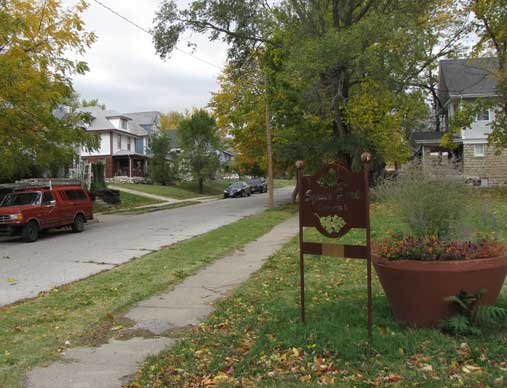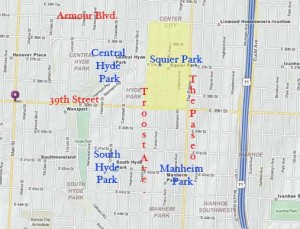
Squier Park is a social neighborhood, its residents say. The neighborhood association has two common areas like this one, where neighbors get together for picnics, the Night Out Against Crime, and other gatherings.
While folks in the suburbs sometimes complain about feeling isolated from neighbors, those who live in urban neighborhoods like Midtown’s Squier Park often feel they are truly living in an urban village. According to Squier Park Neighborhood Association President John Pajor, “We do our best to get to know each other.” Pajor says he, his wife and three children have relished living in an urban core neighborhood that is east of Troost, has been integrated for decades, and provides them with a great “sense of place.” He also loves the fact that he can bike to his job downtown or take the bus if the weather is bad.
Squier Park is hosting its third homes tour this Saturday, and that event is just one of the activities that help strengthen the social fabric there. Vice president Johnathon Bish says the neighborhood gets together for Easter egg hunts, picnics and progressive dinners. “We’re a very social neighborhood,” Bish said. “Virtually everyone in the neighborhood knows everyone else.”

Squire Park encompasses 16 blocks between Armour Boulevard to the north, 39th Street to the south, Paseo Boulevard to the east, and Troost Avenue to the west. It’s recently been named to the National Register of Historic Places because of its architecture.
Like any urban area, Squier Park has its share of challenges. Key among those is the number of vacant homes in the 16-block neighborhood. Landlords who don’t live in the neighborhood also disturb Pajor. “I feel like they are waiting for us to do the work to make this a better neighborhood so they can profit from it.” The neighborhood also has a closed school, Faxon, which it hopes will soon be repurposed into something that will be an asset to residents.
But Pajor says there are also plenty of things to celebrate. He loves the idea that more and more families with young children are moving to his Squier Park neighborhood, and he hopes they will stay as the children reach school age.
“A family with three kids bought the previously-vacant house across the street from us. Recently, I looked out the window and saw the dad had organized a game of kickball. There were neighborhood kids, kids from nearby apartments, and a real sense of participation.”
The neighborhood recently was added to the national historic register, recognized for its architecture. It’s also a part of the Urban Neighborhood Initiative, a joint effort of the Chamber of Commerce and the United Way to strengthen urban core neighborhoods. Pajor says the neighborhood has a great partnership with the DeLeSalle School, which, among other things, offers residents space in its community garden.
Residents also have plans for the future. They want a park or community center , and they’re interested in the idea of popup libraries. And, Bish says, “We’re trying to increase participation and improve the neighborhood.”



Who’s talking